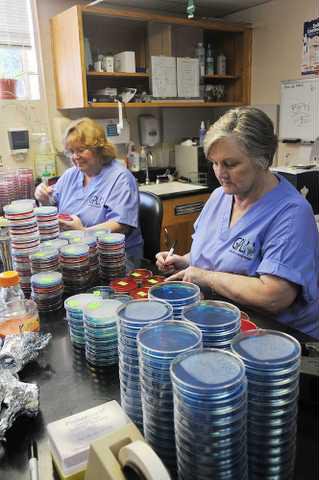OAKWOOD — Instead of moving ahead with plans for some space in its building two years ago, the Georgia Poultry Laboratory off Oakwood Road got a condemnation notice for that area.
It was a serious red flag. After more investigation, the lab discovered it had a plethora of structural and other issues in the red brick, single-story building close to the city's old downtown.
Today, a good chunk of the building is off limits, meaning even closer quarters for workers inside the busy poultry diagnostic and testing center, the flagship for the Georgia Poultry Laboratory Network.
Relief is on the way, however.
A $13.5 million replacement is in the works, with the project in the design phase, construction set to begin in June 2011 and opening in September 2012, 50 years after the current building opened.
"We're very excited about the new lab," said Louise Dufour-Zavala, executive director of the network. "It's going to open up all kinds of possibilities for us, as far as the types and numbers of tests we can do, and the training and workshops we can do."
The new building will open at the same site, with the existing building razed to make room for a parking lot.
Boosting the new lab will be better accessibility, as an adjacent four-lane road, Thurmon Tanner Parkway, is expected to be completed in December.
The final segment of the parkway is being built between Plainview and Mundy Mill roads, crossing Oakwood Road.
When it is finished, the entire Thurmon Tanner will run between Atlanta Highway at Interstate 985 to Phil Niekro Boulevard in Flowery Branch.
Early drawings of the new building show a sharp contrast in architectural styles from the current version, with the new one featuring plenty of glass and steel.
"We really felt we needed a ‘wow' effect," Dufour-Zavala said. "We have a lot of international visitors to this lab - I'm talking government delegations from our export countries.
"They come to Georgia for different reasons, but if they have anything to do with poultry, they'll be in this lab."
Architects sought input from the poultry officials, who said that while the building "has to be a functional place, it also has to be a showplace," Dufour-Zavala said.
The lab also will be more user-friendly to other tour groups.
"Visitors aren't really supposed to go inside the labs to break the flow and (because of) biosafety reasons, so what these architects have managed to do is (design) a mezzanine where you can go upstairs and see inside all the labs," Dufour-Zavala said.
"So, when we have a tour, you're going to have like a bird's eye view."
Georgia's poultry health efforts date to the 1920s, when the commercial industry started to flourish.
The Georgia Department of Agriculture instituted a program of testing for pullorum, a fatal disease of young poultry caused by salmonella.
The U.S. Department of Agriculture later created the National Poultry Improvement Plan as a way to eradicate pullorum. States didn't have to belong, but Georgia jumped on the bandwagon creating the Poultry Breed Supervisory Board, which later became the Georgia Poultry Improvement Association.
The association built its Gainesville lab in 1946, moving to the Oakwood building in 1962. The poultry network has five branch labs throughout Georgia.
The network "plays a vital role in poultry health in Georgia," said Abit Massey, president emeritus of the Gainesville-based Georgia Poultry Federation.
"Fortunately, Georgia has not had avian influenza but, in an abundance of precaution, every flock of chickens is tested through the labs before going to processing plants."
The Oakwood lab has several departments, with most of the testing related to isolation of bacteria and fungi, especially salmonella, and serology, or tests performed for diagnostic purposes using blood serum.
Poultry companies and private growers bring by various kinds of samples — such as blood, litter and feces — for testing, mostly for diseases.
"A lot of it is to make sure Georgia poultry is free from undesirable infections," Dufour-Zavala said.
The lab network receives most of its funding from the Georgia Department of Agriculture. It gets some money from the U.S. Department of Agriculture for an avian influenza program.
In addition to structure problems, it became clear over the years that the Oakwood lab also had functional issues.
"It became very difficult to handle the flow of samples and (deal with) biosecurity and biosafety issues because this lab wasn't originally designed to handle high containment situations," Dufour-Zavala said.
Some areas of the building "are really, really congested and in some areas, there looks like there's enough space but because over the years our missions have shifted ... where we had the space is not where we really needed it," she added.
And then there are some "really critical areas, like sample receiving and bacteriology, that are really cramped."
Massey said he is excited about the new lab becoming a reality.
"The Georgia poultry industry has grown dramatically since the Oakwood lab was built," he said.
"The new lab will enable (the industry) to continue and increase the services for the poultry industry - the largest segment of Georgia agriculture and agribusiness, and still growing."

